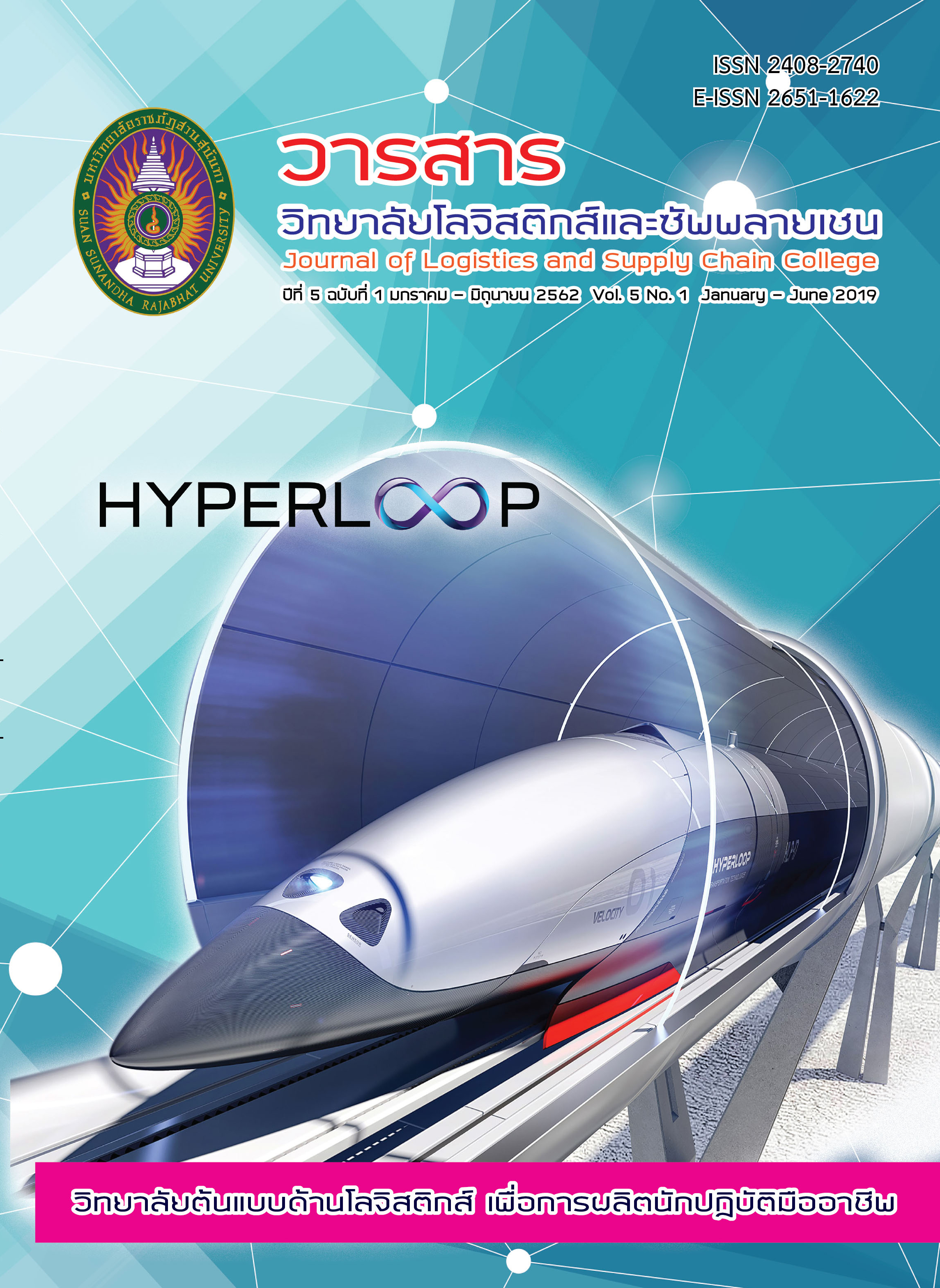Database and Information System for Disposal Fee of Waste: A Case Study of Bandu Municipality, Muang Chiang Rai District, Chiang Rai Province
Abstract
The purpose of this research was to explore the quantity and nature of garbage by type of public housing and to compile a database and report waste results to all concerned parties. It consists of the garbage collector, the health department, and the waste collection department, the revenue department of Ban Du Subdistrict to have a data link. The Junk information system was operated on the record of the amount of waste. Locations and types of residences, such as houses, shops, companies, and the preparation of reports to link the relevant departments to the efficient management of waste with software packages by computer system - in content management and website by data collection. The researcher also created a database for use within the organization and use the server as a medium of work. The system was developed to help database users understand and find appropriate information. The result of to explore the quantity and nature of garbage by type of public housing found that there are garbage collection points in 19 villages those were surveyed, and the amount of garbage is weighed at each point. Ban Du Subdistrict Municipality has 5 garbage trucks, each vehicle collects 2-3 trips in its area. There is a lot of garbage, especially the 1st trip on Monday, Tuesday, and Wednesday because Sunday is a day off, there. There is garbage about 100 tons per week, and 30 tons per day on average. And the results of database system trial revealed that the system could link data between two user segments in the revenue department and the health department. The information could also be revealed payment information of the garbage collector that facilitated data validation. The revenue department can log in to view the payment status of the garbage collector, view reports in graph format, add, delete, and modify all data in the database. Also, the collectors could print annual summary of payments or print a blank form for manual survey. Division of Public Health of Ban Du District could login to see the collector's payment status. It facilitates data validation and provides a sticker that specifies a monthly or annual payment and view reports in graph format.
References
กิตติ ภักดีวัฒนะกุล. (2541). การออกแบบฐานข้อมูล. กรุงเทพฯ: เคทีพี คอมพ์ แอนด์ คอนซัลท์.
กิตติพงษ์ จั่นเพชร. (2554). การออกแบบระบบฐานข้อมูลในการลดจำนวนเศษการผลิตของบรรจุภัณฑ์ IC กรณีศึกษาอุตสาหกรรมเซมิคอนดักเตอร์.วิทยานิพนธ์ มหาวิทยาลัยเทคโนโลยีพระจอมเกล้าพระนครเหนือ.
เกียรติพงษ์ สันตะบุตร (2551). ซัพพลายเชนสำหรับผู้จัดการ = Supply Chains: A Manager's Guide. เอ็กซเปอร์เน็ท. กรุงเทพ.
คำรณ ศรีน้อย. 2549. การจัดการเทคโนโลยี : กุญแจแห่งการแข่งขันและการสร้างสรรค์ของสังคมโลก. สำนักพิมพ์แห่งจุฬาลงกรณ์มหาวิทยาลัย. กรุงเทพ.
คำนาย อภิปรัชญากุล. (2553). โลจิสติกส์และโซ่อุปทาน. บริษัท โฟกัส มีเดีย แอสด์ พับลิช ชิ่ง จำกัด. กรุงเทพ.
ดุสิต ขาวเหลือง. “การพัฒนาระบบฐานข้อมูลสารสนเทศ ภาควิชาเทคโนโลยีทางการศึกษา มหาวิทยาลัยบูรพา บนเครือข่ายอินเทอร์เน็ต : ด้านการบริหารงาน”. ศึกษามหาบันฑิต สาขาเทคโนโลยีทางศึกษา บัณฑิตวิทยาลัยมหาวิทยาลัยบูรพา, 2546.
พลวิทย์ นิธิเนตติยานนท์. (2556). การออกแบบฐานข้อมูลฟาร์มสุกรจรัญฟาร์ม. วิทยานิพนธ์วิทยาศาสตรมหาบัณฑิต (เทคโนโลยีสารสนเทศ). กรุงเทพฯ : มหาวิทยาลัยเทคโนโลยีพระจอมเกล้าธนบุรี.
ภาคภูมิ ปานทรัพย์. (2556) การออกแบบระบบฐานข้อมูลสินค้าของร้านกรุงเทพฮาร์ดแวร์. (ปริญญาวิทยาศาสตรมหาบัณฑิต).มหาวิทยาลัยเทคโนโลยีพระจอมเกล้าธนบุรี. สืบค้นจาก ฐานข้อมูลวิจัย Thailis Digital Collection.
ทัศนีย์วรรณ นวลหนู. (2556). การจัดการของเสียอันตรายจากชุมชนขององค์กรปกครองส่วนท้องถิ่น. วิทยานิพนธ์วิทยาศาสตรมหาบัณฑิต (การจัดการสิ่งแวดล้อม). กรุงเทพฯ: สถาบันบัณฑิตพัฒนบริหารศาสตร์.
ปิยชาติ ศิลปสุวรรณ. (2557). ขยะมูลฝอยชุมชน ปัญหาใหญ่ที่ประเทศไทยกำลังเผชิญ.สำนักงานวิชาการ สำนักงานเลขาธิการ วุฒิสภา ปีที่ 4 ฉบับที่ 7 เดือน เมษายน 2557.
สำนักงานนโยบายและแผนทรัพยากรธรรมชาติและสิ่งแวดล้อม. (ม.ป.ป.). สาระสำคัญนโยบายและแผนการส่งเสริมและรักษาคุณภาพสิ่งแวดล้อมแห่งชาติ พ.ศ. 2540 – 2549. เข้าถึงได้จาก: https://www.onep.go.th/ policy/policy1.asp
สุภกิณห์ สมศรี. (2545). การศึกษาแนวทางการจัดการขยะมูลฝอยในมหาวิทยาลัยเทคโนโลยีสุรนารี ด้วยเทคโนโลยีระบบสารสนเทศภูมิศาสตร์. วิทยานิพนธ์วิศวกรรมศาสตรมหาบัณฑิต สาขาวิชาวิศวกรรมสิ่งแวดล้อม. มหาวิทยาลัยเทคโนโลยีสุรนารี: นครราชสีมา.
Alter S. Information Systems: A Management Perspective. 3rd Edition. (1999) Addison Wesley, USA.
DeLone, W. H., & McLean, E. R. (1992). Information systems success: The quest for the dependent variable. Information Systems Research, 8(3), 240-253.
DeLone, W. H., & McLean, E. R. (2002). Information systems success revisited. In Proceedings of the 35th Hawaii international conference on system sciences (HICSS 02), January 7–10.Big Island, Hawaii.
Laudon C. K., & Laudon P. J. Management Information Systems: Managing the Digital Firm. 9th Edition. (2005). Prentice Hall. USA.
Lucas C. H. (1997). Information Technology for Managment. 6th Edition. Mcgraw-Hill. Singapore.
Martin E. W., Brown V. C., DeHayes W. D., Hoffer A. J., & Perkins C. W. (2005). Managing Information Technology. 5th Edition. Pearson Prentice Hall. USA.
Post V. G., & Anderson L. D. (2006). Management Information System.: Solving Business Problem with Information Technology. 4th Edition. Mcgraw-Hill Irwin. USA.
Schulthesis R., & Sumner M. (1998). Managemet Information Systems: The Manager’s View. 4th Edition. Irwin Mcgraw-Hill. USA.
Turban E., McLean E., & Wetherbe J. (2001). Information Technology for Management: Making Connections for Strategic Advantage. 2nd Edition. John Wiley & Sons, Inc. USA.



